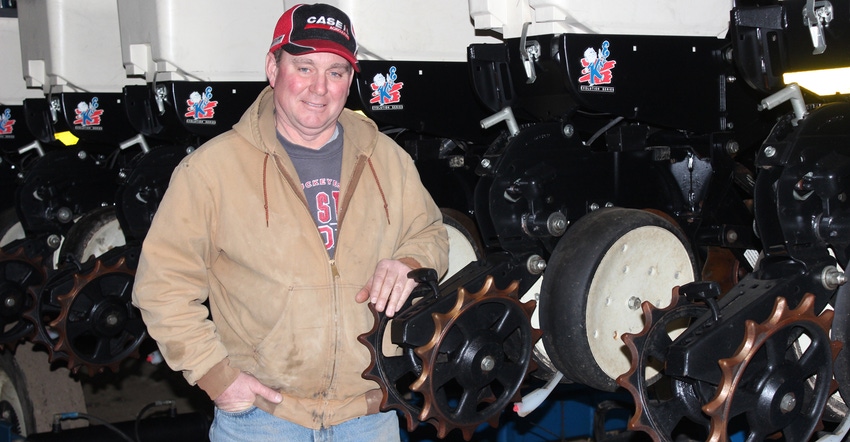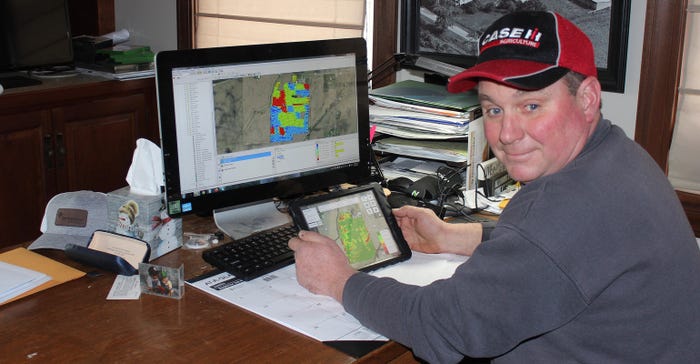
Even though Mike Wolfe doesn’t have livestock, he wants the soil in his crop fields to resemble the soil in a long-term pasture.
He’s been working to protect his soils with conservation tillage practices ever since he started farming in the 1980s — but just preventing erosion isn’t enough, he says. Several years ago, he started raising crops on some land that had been used for pasture, and he could see the difference in the quality of the soil.
Now he’s working to replicate that quality in his crop fields. “Part of my goal is to rebuild that soil structure and organic matter,” he explains.
Wolfe farms about 1,500 acres in Fairfield County, Ohio, including some land that’s been in his family since 1929. His father, Roger Wolfe, was an outspoken advocate of soil conservation who began no-tilling in 1979. Mike Wolfe followed his example, winning the county’s no-till yield contest in 1983, when he was in high school.
In the years since, Wolfe has expanded the farm’s acreage and continued to follow conservation practices. Last year, with a plot of strip tilled corn, he placed first in Ohio in the National Corn Growers Association yield contest for the Strip-, Mininum-, Mulch- and Ridge-till Non-Irrigated category. He harvested 294.5631 bushels per acre with Dekalb DKC64-35RIB.
Wolfe uses no-till and strip tillage to raise corn and soybeans, along with some wheat and cover crops. After corn and soybeans, he normally plants a cover crop of cereal rye or triticale. If he doesn’t plant double-crop soybeans after wheat, he likes to use a cover crop mix with radishes, winter peas and rye. Depending on the weather and ground conditions, he’s usually able to cover two-thirds to three-fourths of his ground with cover crops each year. “We’ve planted up to Thanksgiving,” he says. The later-planted cover crops don’t always have enough time to become well-established in the fall, but they still usually provide some benefits, he explains.
Besides building soil organic matter with cover crops, Wolfe has been seeking out sources of organic matter to amend and fertilize his soil. He started with municipal sludge from a nearby wastewater treatment facility and saw good results in the soil. However, timing of the application was a problem, and he struggled with soil compaction. He also had timing problems with chicken litter, because the farm supplying the litter had no storage and needed it hauled out between groups of birds, with a one-week turnaround.

WINTER COVER: Cover crops like this cereal rye help Wolfe protect the soil from erosion and hold nutrients in the soil.

Success with Com-Til
His best option so far has been Com-Til, a composted blend of yard waste along with biosolids from wastewater treatment. He’s getting it from the city of Columbus, and he can pick it up whenever he’s ready to spread it. If field conditions are dry enough, he broadcasts it over the top of growing cover crops in the fall. If the fall is too wet, he puts it on before planting in the spring.
Another advantage of the Com-Til is that it has a more consistent nutrient analysis than the chicken litter he has used. The city of Columbus provides an analysis, but Wolfe also has an independent analysis done so he can accurately plan application rates. He’s found the nutrient levels measured by the independent analysis run a little higher than the analysis provided by the city.
Wolfe started experimenting with Com-Til in 2015, with check plots in three fields. He’s gradually increased usage each year since. For the 2020 crop year, he applied a total of 1,000 tons, supplying all his phosphorus needs for the year. The cost of the phosphorus is a little lower with Com-Til than with monoammonium phosphate (MAP), but application costs are a little higher because of the bulk of the material. However, Wolfe points out, the added value of the nitrogen, potassium, micronutrients and organic matter offsets the increase in application costs.
When he first starts applying Com-Til in a field, Wolfe covers the entire field with about 2 tons per acre to boost organic matter throughout the field. Then, he follows soil tests and uses variable-rate application depending on needs. For instance, some areas might get an additional 3 tons per acre, and other areas might not get any. He uses zone sampling for all his fields, dividing fields into fertility zones based on soil type and field history, with no more than 3 or 4 acres in each zone.
Both the city of Columbus and Ohio State University are working with Wolfe to study the long-term effects of using Com-Til on soil health, fertility and yields. The changes take time, but reintroducing organic matter is making a difference, Wolfe says. “It’s not like the first year you see a big bump, but we’re seeing a gradual improvement.”

SOIL IMPROVEMENT: Wolfe is working to build the organic matter in his soil and improve the soil structure by applying manure or composted municipal sludge on top of cover crops.

Yield strategies
Wolfe and his dad won several ridge tillage yield awards in the 1980s and ’90s, but he had gotten away from entering yield contests in recent years. Then last year his wife, Maria, saw that the awards for the 2019 contest would be presented at the Commodity Classic in San Antonio, so she encouraged him to enter in hopes of winning a trip. “That’s her favorite city to visit,” Wolfe explains.
He picked a high-yielding field he calls the “contest field.” It’s the same one he and his dad always used for contest entries because of its fertility and good drainage. They started no-tilling there in the mid-’80s, used ridge tillage in the late ’80s and began strip tillage in the mid-’90s. The ground hasn’t been plowed in more than 30 years, he notes.
Wolfe used the same overall production practices he uses on the rest of his land for the contest plot. In mid-October 2018, he broadcast-planted 25 pounds per acre of triticale and used light vertical tillage to cover the seed. In late October, he put on 2 tons per acre of Com-Til, then strip tilled in early April, applying 160 pounds of NH3.

MAPPING PROGRESS: Mike Wolfe’s computer screen shows variable lime application rates in the field he used for his yield contest entry. His hand-held pad screen shows the corn yields.

From burndown to harvest
To burn down the cover crop ahead of planting, Wolfe used simazine, dicamba and glyphosate. For early postemergence weed control, he used atrazine, Explorer, Zidua and glyphosate. He also had Headline Amp fungicide applied with a helicopter when the corn was at the brown silk stage to control gray leaf spot and northern leaf blight.
He planted May 9, while applying 9 gallons of 28% N and 3 gallons of ammonium thiosulfate per acre in a 2-by-2 band. He also put on 5 gallons of 7-22-1.2 along with Xanthion fungicide in the furrow. Then on July 9, just before the corn tasseled, he used Y-drops to apply 18 gallons of 28% N, 2 gallons of ammonium thiosulfate and a quart of nitrogen stabilizer.
The late-sidedress application really helped the crop finish, he explains. “That gained us about 20 bushels per acre.” Timing a late-sidedress application can be tricky, though, he adds. Last year, it was almost too late when he was able to get in the field, and he ended up breaking the tops of a few stalks.
Precision planting technology also helps contribute to top yields by improving seed placement, Wolfe adds. He chose the hybrid Dekalb DKC64-35RIB, based on its impressive performance in check plots he’s put out for his local co-op. “It won the hybrid plots two years in a row,” he explains.
Wolfe harvested his contest plot Oct. 15 at 16% moisture.
Unlike farmers in some other parts of the state, he didn’t struggle with bad weather last year. The spring wasn’t excessively wet, and the weather didn’t turn dry until September, he says. “We were very blessed with weather this year.”
Keck writes from Raymond, Ohio.
About the Author(s)
You May Also Like




